жӮЁеҘҪпјҢзҷ»еҪ•еҗҺжүҚиғҪдёӢи®ўеҚ•е“ҰпјҒ
жӮЁеҘҪпјҢзҷ»еҪ•еҗҺжүҚиғҪдёӢи®ўеҚ•е“ҰпјҒ
жң¬зҜҮеҶ…е®№дё»иҰҒи®Іи§ЈвҖңC++дёӯж Ҳзҡ„еә”з”ЁвҖқпјҢж„ҹе…ҙи¶Јзҡ„жңӢеҸӢдёҚеҰЁжқҘзңӢзңӢгҖӮжң¬ж–Үд»Ӣз»Қзҡ„ж–№жі•ж“ҚдҪңз®ҖеҚ•еҝ«жҚ·пјҢе®һз”ЁжҖ§ејәгҖӮдёӢйқўе°ұи®©е°Ҹзј–жқҘеёҰеӨ§е®¶еӯҰд№ вҖңC++дёӯж Ҳзҡ„еә”з”ЁвҖқеҗ§!
1гҖҒж Ҳзҡ„еә”з”Ё1 и§ЈеҶіиҝ·е®«й—®йўҳ
й—®йўҳпјҡдёҖдёӘn*nзҡ„0гҖҒ1зҹ©йҳөпјҢ0 иЎЁзӨәеҸҜд»Ҙиө°йҖҡпјҢ1иЎЁзӨәдёҚеҸҜд»Ҙиө° пјҢеҒҮе®ҡзҹ©йҳөзҡ„дёӢиҫ№жҳҜеҮәеҸЈпјҢз»ҷе®ҡзҹ©йҳөзҡ„е…ҘеҸЈеқҗж ҮпјҢжұӮеҮәиө°еҮәиҝ·е®«зҡ„и·Ҝеҫ„
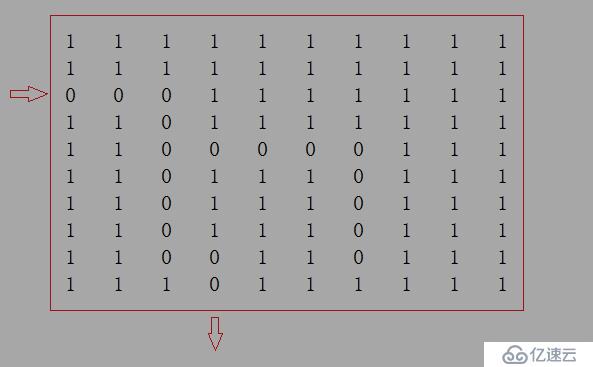
иҝҷйҮҢз”Ё ж Ҳ дё»иҰҒжҳҜи§ЈеҶі еҰӮеӣҫжүҖзӨә иө°дёҚеҮәеҺ» дјҡйҖҖж—¶дёҠдёҖжӯҘпјҲеҮәж Ҳпјү дҪҚзҪ®зҡ„и®°еҪ•
д»ҘеҸҠ и®°еҪ•е·Із»Ҹиө°иҝҮзҡ„и·Ҝеҫ„пјҲеҺӢж Ҳпјү
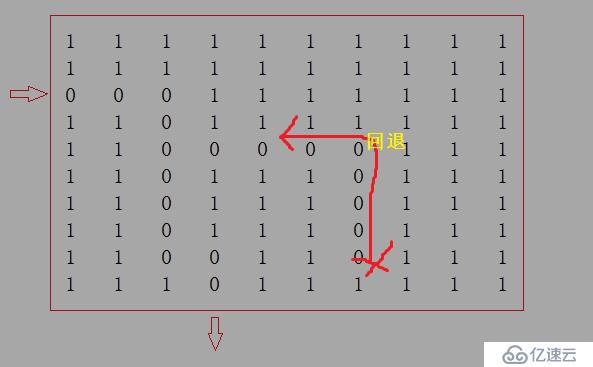
жү©еұ• пјҡ(1) йқһйҖ’еҪ’жі•е®һзҺ°
пјҲйҖ’еҪ’жі• дёҺ йқһйҖ’еҪ’ зҡ„ дёҖзӮ№дёҚеҗҢ
йҖ’еҪ’жі•дёҚдјҡеҮәзҺ° е°қиҜ•дёӢдёҖжӯҘеӨұиҙҘеҗҺ йҖҖеҲ°дёҠдёҖжӯҘ еҶҚж¬Ўе°қиҜ•дёӢдёҖжӯҘж—¶ дёҚдјҡеҮәзҺ° йҮҚеӨҚ е°қиҜ•дёҠдёҖж¬Ўиө°й”ҷзҡ„йӮЈдёӘвҖңдёӢдёҖжӯҘвҖқ иҖҢ дёӢйқўдҪҝз”Ё ж Ҳзҡ„ж–№ејҸзҡ„ йҖҖж Ҳж—¶ дёӢдёҖжӯҘе°қиҜ•иҝҳдјҡеҲӨж–ӯ е·Іиө°иҝҮдёҚжҲҗеҠҹзҡ„жғ…еҶөгҖҗйҮҚеӨҚеҲӨж–ӯдёҖж¬ЎгҖ‘пјү
(2) еӨҡдёӘеҮәеҸЈ жңҖзҹӯи·Ҝй—®йўҳ гҖҗеңЁдёӢйқўе®һзҺ°гҖ‘
//-----------------Maze.h---------
#pragma once
#define N 10
#define MAZEPATH "MazeMap.txt"
#include<iostream>
using namespace std;
#include <assert.h>
#include <stack>
struct Pos
{
int _row;
int _col;
};
void GetMaze(int* a, int n);
void PrintMaze(int* a, int n);
bool MazePath(int* a, int n, const Pos entry, stack<Pos>& path);
//-----------------Maze.cpp-----------
#define _CRT_SECURE_NO_WARNINGS 1
// ж Ҳеә”з”Ёпјҡиҝ·е®«(n*n)й—®йўҳ
#include "Maze.h"
void GetMaze(int* a, int n)
{
FILE* f_out = fopen(MAZEPATH, "r");
assert(f_out != NULL);
for (int i = 0; i < n; i++)
{
for (int j = 0; j < n; )
{
char ch = fgetc(f_out);
if (ch == '0' || ch == '1') //йҖҡи·Ҝдёә0 дёҚйҖҡи·Ҝ2
{
a[i*n + j] = ch - '0';
++j;
}
else
{
continue;
}
}
}
fclose(f_out);
}
void PrintMaze(int* a, int n)
{
for (int i = 0; i < n; i++)
{
for (int j = 0; j < n; j++ )
{
cout<<a[i * n + j]<<" ";
}
cout<<endl;
}
}
bool CheckIsAccess(const int *a, int n, const Pos& next) //еҲӨж–ӯи·ҜйҖҡдёҚйҖҡ
{
assert(a);
if (next._row >= 0 && next._row < n
&& next._col >= 0 && next._col < n
&& a[next._row * n + next._col] == 0)// 0 иЎЁзӨәи·ҜйҖҡ
{
return true;
}
else
{
return false;
}
}
// const Pos entry е…ҘеҸЈ , stack<Pos>& path з”ЁдәҺеҺӢи·Ҝеҫ„зҡ„ ж Ҳ
bool MazePath(int* a, int n, const Pos entry, stack<Pos>& path)
{
Pos cur = entry;
path.push(cur);
while (!path.empty()) // ж— и·Ҝиө°ж—¶ж Ҳз©ә
{
a[cur._row * n + cur._col] = 2;// иө°иҝҮзҡ„и·Ҝж Үи®° 2
// е®ҡд№үж•°з»„ жңҖдёӢиҫ№дёә еҮәеҸЈ
if (cur._row == n - 1) // еҲӨж–ӯжҳҜеҗҰеҲ°еҮәеҸЈ
{
return true;
}
Pos next = cur;
// еҗ‘дёҠ жҺўзҙў
next._row--;
if (CheckIsAccess(a, n, next))
{
cur = next;
path.push(cur);
continue;
}
// еҗ‘еҸі жҺўзҙў
next = cur;
next._col++;
if (CheckIsAccess(a, n, next))
{
cur = next;
path.push(cur);
continue;
}
// еҗ‘дёӢ жҺўзҙў
next = cur;
next._row++;
if (CheckIsAccess(a, n, next))
{
cur = next;
path.push(cur);
continue;
}
// еҗ‘е·Ұ жҺўзҙў
next = cur;
next._col--;
if (CheckIsAccess(a, n, next))
{
cur = next;
path.push(cur);
continue;
}
// иө°дёҚйҖҡ
a[cur._row * n + cur._col] = 5;// ж ҮеҮәй”ҷиҜҜи·Ҝзәҝ
path.pop();
if (!path.empty())
{
cur = path.top();
}
}
return false;
}
//---------------------test.cpp----------------------
#define _CRT_SECURE_NO_WARNINGS 1
#include "Maze.h"
void TestMaze()
{
int a[N][N] = {};
GetMaze((int*)a, N);
PrintMaze((int*)a, N);
stack<Pos> path;
Pos entry = {2, 0};
MazePath((int*)a, N, entry, path);
cout<<"------------------------------"<<endl;
PrintMaze((int*)a, N);
}
int main()
{
TestMaze();
getchar();
return 0;
}
//--------------MazeMap.txt----------------
1 1 1 1 1 1 1 1 1 1
1 1 1 1 1 1 1 1 1 1
0 0 0 1 1 1 1 1 1 1
1 1 0 1 1 1 1 1 1 1
1 1 0 1 1 1 1 1 1 1
1 1 0 1 1 1 1 1 1 1
1 1 0 0 0 0 0 0 1 1
1 1 0 1 1 1 1 0 1 1
1 1 0 1 1 1 1 0 1 1
1 1 0 1 1 1 1 1 1 1
//////////////////////////////////////////////////////////////////////
/////////////////////////////////////////////////////////////////////
2гҖҒж Ҳзҡ„еә”з”Ё2 йҖҶжіўе…°ејҸи®Ўз®—
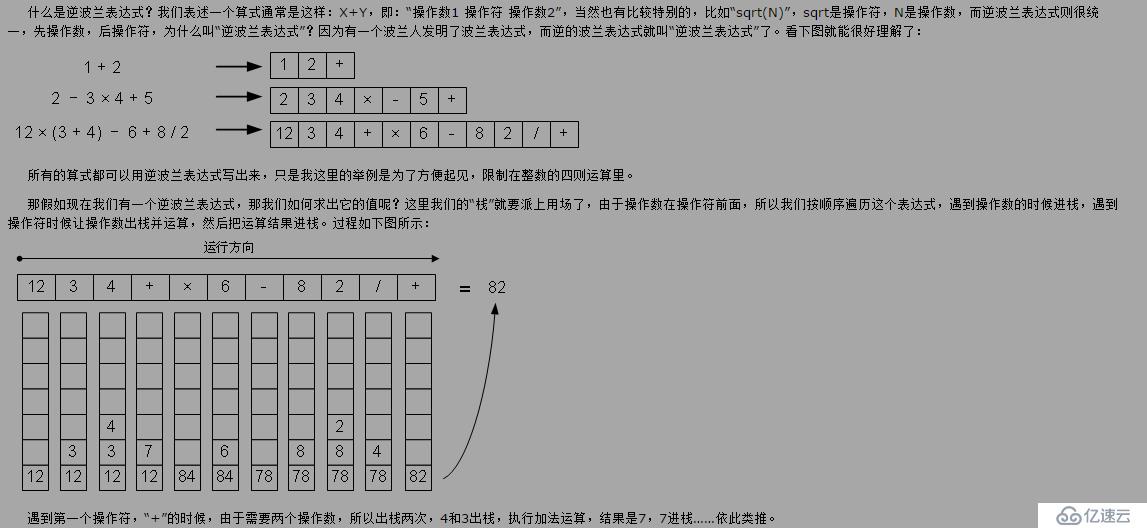
#define _CRT_SECURE_NO_WARNINGS 1
#include<iostream>
#include<assert.h>
#include<stack>
using namespace std;
// ж Ҳзҡ„еә”з”Ё 2 з®—ж•°иЎЁиҫҫејҸжұӮи§Ј
enum Type
{
OP_NUM,
OP_SYMBOL
};
struct Cell
{
Type type;
int value;
};
enum SYMBOL
{
ADD,
SUB,
MUL,
DIV
};
int CountRNP(Cell* a,size_t size)
{
assert(a);
stack<int> s;
for (size_t i = 0; i < size; i++)
{
if (a[i].type == OP_NUM)
{
s.push(a[i].value);
}
else
{
int right = s.top();// жіЁж„Ҹ еҺӢж Ҳ дёҺиЎЁиҫҫејҸ йЎәеәҸдёҚеҗҢ
s.pop();
int left = s.top();
s.pop();
switch (a[i].value)
{
case ADD:
s.push(left + right);
break;
case SUB:
s.push(left - right);
break;
case MUL:
s.push(left * right);
break;
case DIV:
s.push(left / right);
break;
}
}
}
return s.top();
}
void TestRnp()
{
Cell a[] =
{
{OP_NUM, 12},
{OP_NUM, 3},
{OP_NUM, 4},
{OP_SYMBOL, ADD},
{OP_SYMBOL, MUL},
{OP_NUM, 6},
{OP_SYMBOL, SUB},
{OP_NUM, 8},
{OP_NUM, 2},
{OP_SYMBOL, DIV},
{OP_SYMBOL, ADD}
};
int ret = CountRNP(a, sizeof(a)/sizeof(a[0]));
}
int main()
{
TestRnp();
return 0;
}
////////////////////////////////////////////////////
////////////////////////////////////////////////////
//----------------иҝ·е®« йҖ’еҪ’жі•пјҲдёҚз”Ёж Ҳпјү---------
// йҖ’еҪ’жі• дёҚйңҖиҰҒж Ҳ
bool MazePath(int* a, int n, Pos cur)
{
// е®ҡд№үж•°з»„ жңҖдёӢиҫ№дёә еҮәеҸЈ
if (cur._row == n - 1 && a[cur._row * n + cur._col] == 0) // еҲӨж–ӯжҳҜеҗҰеҲ°еҮәеҸЈ
{
a[cur._row * n +cur._col] = 2; // 2 иЎЁзӨәжӯӨи·ҜеҸҜиө°
return true;
}
if (CheckIsAccess(a, n, cur))
{
a[cur._row * n +cur._col] = 2; // 2 иЎЁзӨәжӯӨгҖҗзӮ№гҖ‘еҸҜиө° дёӢдёҖжӯҘиҝҳдёҚзҹҘйҒ“
Pos next_left = cur;
next_left._col--;
Pos next_right = cur;
next_right._col++;
Pos next_up = cur;
next_up._row--;
Pos next_down = cur;
next_down._row++;
bool next = (MazePath((int*)a, n, next_up)
|| MazePath((int*)a, n, next_right)
|| MazePath((int*)a, n, next_down)
|| MazePath((int*)a, n, next_left));
if (!next)
{
a[cur._row * n +cur._col] = 5; //5иЎЁзӨә дёӢдёҖжӯҘиө°дёҚеҮәеҺ» жҠҠеҪ“еүҚзӮ№д»Һ2еҸҳеҲ°дә” иЎЁзӨәиҝҷдёӘзӮ№иө°дёҚеҮәеҺ»
return false;
}
else
{
return true;
}
}
else //cur дёҚиғҪиө°
{
return false;
}
}
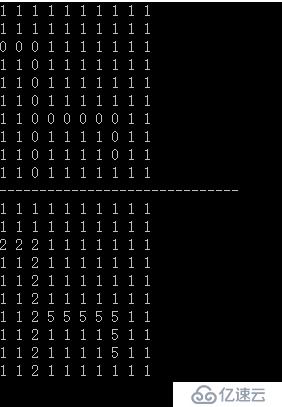
2 иЎЁзӨәжҲҗеҠҹи·Ҝзәҝ
5 иЎЁзӨә е°қиҜ•еӨұиҙҘзҡ„и·Ҝзәҝ
/////////////////////////////////////////////////////////////
///////////////////////////////////////////////////////////
//--------------------иҝ·е®« пјҲжңҖзҹӯи·Ҝпјү ---------------
//-------------------Maze.h--------------------
#pragma once
#define N 10
#define DEBUGE 0 // 1 и°ғиҜ• 0 дёҚи°ғиҜ•
#define MAZEPATH "MazeMap.txt"
#include<iostream>
using namespace std;
#include <assert.h>
#include <stack>
struct Pos
{
int _row;
int _col;
};
//stack<Pos> MinPath;
void GetMaze(int* a, int n);
void PrintMaze(int* a, int n);
bool MazePath(int* a, int n, const Pos entry, stack<Pos>& path);
bool FindMinPath(int* a, int n, const Pos entry ,stack<Pos>& MinPath);
int GetCount(stack<Pos> path);
//---------------------------Maze.cpp-----------------
#define _CRT_SECURE_NO_WARNINGS 1
// ж Ҳеә”з”Ё2пјҡиҝ·е®«(n*n)й—®йўҳ
#include "Maze.h"
void GetMaze(int* a, int n)
{
FILE* f_out = fopen(MAZEPATH, "r");
assert(f_out != NULL);
for (int i = 0; i < n; i++)
{
for (int j = 0; j < n; )
{
char ch = fgetc(f_out);
if (ch == '0' || ch == '1') //йҖҡи·Ҝдёә0 дёҚйҖҡи·Ҝ2
{
a[i*n + j] = ch - '0';
++j;
}
else
{
continue;
}
}
}
fclose(f_out);
}
void PrintMaze(int* a, int n)
{
for (int i = 0; i < n; i++)
{
for (int j = 0; j < n; j++ )
{
cout<<a[i * n + j]<<" ";
}
cout<<endl;
}
}
bool CheckIsAccess(const int *a, int n, const Pos& next) //еҲӨж–ӯи·ҜйҖҡдёҚйҖҡ
{
assert(a);
if (next._row >= 0 && next._row < n
&& next._col >= 0 && next._col < n
&& a[next._row * n + next._col] == 0)// 0 иЎЁзӨәи·ҜйҖҡ
{
return true;
}
else
{
return false;
}
}
// const Pos entry е…ҘеҸЈ , stack<Pos>& path з”ЁдәҺеҺӢи·Ҝеҫ„зҡ„ ж Ҳ
bool MazePath(int* a, int n, const Pos entry, stack<Pos>& path)
{
Pos cur = entry;
path.push(cur);
while (!path.empty()) // ж— и·Ҝиө°ж—¶ж Ҳз©ә
{
a[cur._row * n + cur._col] = 2;// иө°иҝҮзҡ„и·Ҝж Үи®° 2
// е®ҡд№үж•°з»„ жңҖдёӢиҫ№дёә еҮәеҸЈ
if (cur._row == n - 1) // еҲӨж–ӯжҳҜеҗҰеҲ°еҮәеҸЈ
{
return true;
}
Pos next = cur;
// еҗ‘дёҠ жҺўзҙў
next._row--;
if (CheckIsAccess(a, n, next))
{
cur = next;
path.push(cur);
continue;
}
// еҗ‘еҸі жҺўзҙў
next = cur;
next._col++;
if (CheckIsAccess(a, n, next))
{
cur = next;
path.push(cur);
continue;
}
// еҗ‘дёӢ жҺўзҙў
next = cur;
next._row++;
if (CheckIsAccess(a, n, next))
{
cur = next;
path.push(cur);
continue;
}
// еҗ‘е·Ұ жҺўзҙў
next = cur;
next._col--;
if (CheckIsAccess(a, n, next))
{
cur = next;
path.push(cur);
continue;
}
// иө°дёҚйҖҡ
a[cur._row * n + cur._col] = 5;// ж ҮеҮәй”ҷиҜҜи·Ҝзәҝ
path.pop();
if (!path.empty())
{
cur = path.top();
}
}
return false;
}
int GetCount(stack<Pos> path)
{
int count = 0;
while(!path.empty())
{
count += 1;
path.pop();
}
return count;
}
void huanyuan(int* a,int n, stack<Pos> Path) // PathдёҚз”Ёеј•з”Ё
{
while(!Path.empty())
{
a[Path.top()._row * n + Path.top()._col] = 0;
Path.pop();
}
}
bool FindMinPath(int* a, int n, const Pos entry,stack<Pos>& MinPath)
{
bool next = false;
bool ret = false;
do
{
stack<Pos> path;
next = MazePath(a, n, entry, path);
//----------------debuge----------
#if DEBUGE
cout<<"-----------------------------"<<endl;
PrintMaze(a,n);
#endif
if (next)
{
if (MinPath.empty())
{
MinPath = path;
}
else
{
if (GetCount(MinPath) > GetCount(path))
{
MinPath = path; // жӣҙж–°MinPath
}
}
huanyuan((int*)a, n, path);// е°Ҷе·Із»Ҹиө°иҝҮзҡ„и·Ҝ 2 ж Үи®°дёә 0
a[path.top()._row * n + path.top()._col] = 9; // жӯӨеҮәеҸЈе·Із»Ҹе өдҪҸ
//--------------debuge---------
#if DEBUGE
cout<<"-------------huanyuan----------------"<<endl;
PrintMaze(a,n);
#endif
ret = true;
}
}while(next);
if (ret)
{
huanyuan(a, n, MinPath);
//a[MinPath.top()._row * n + MinPath.top()._col] = 2; //жү“ејҖиҝҷдёӘжңҖзҹӯи·ҜеҮәеҸЈ
}
return ret;
}
//--------------------------------test.cpp-----------------
#define _CRT_SECURE_NO_WARNINGS 1
#include "Maze.h"
void TestMaze()
{
int a[N][N] = {};
GetMaze((int*)a, N);
PrintMaze((int*)a, N);
stack<Pos> path;
stack<Pos> MinPath;
Pos entry = {2, 0};
FindMinPath((int*)a, N, entry ,MinPath);
cout<<"------------------------------"<<endl;
PrintMaze((int*)a, N);
}
int main()
{
TestMaze();
getchar();
return 0;
}
//----------------------------MazeMap.txt---------------------
1 1 1 1 1 1 1 1 1 1
1 1 1 1 1 1 1 1 1 1
0 0 0 1 1 1 1 1 1 1
1 1 0 1 1 1 1 1 1 1
1 1 0 1 1 1 1 1 1 1
1 1 0 1 1 1 1 1 1 1
1 1 0 0 0 0 0 0 1 1
1 1 0 1 1 1 1 0 1 1
1 1 0 1 1 1 1 0 1 1
1 1 0 1 1 1 1 0 1 1
иҝҗиЎҢеӣҫпјҡ
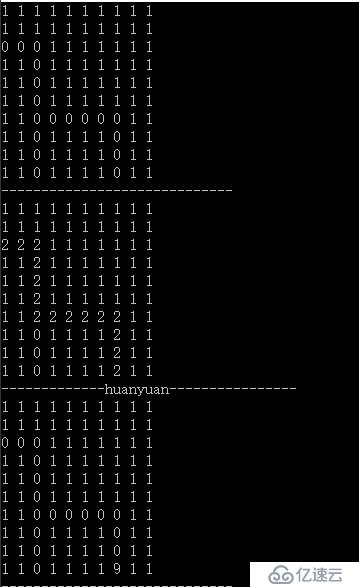
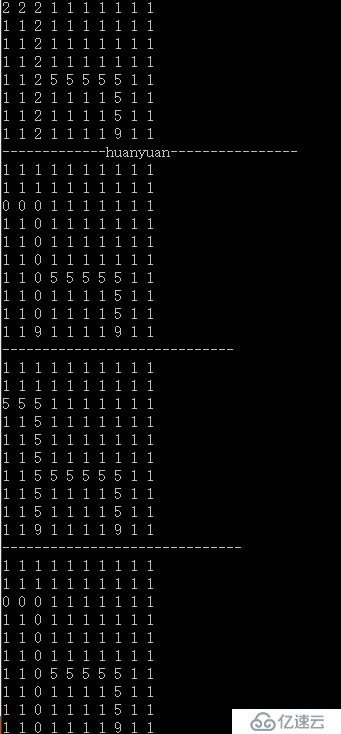
еҲ°жӯӨпјҢзӣёдҝЎеӨ§е®¶еҜ№вҖңC++дёӯж Ҳзҡ„еә”з”ЁвҖқжңүдәҶжӣҙж·ұзҡ„дәҶи§ЈпјҢдёҚеҰЁжқҘе®һйҷ…ж“ҚдҪңдёҖз•Әеҗ§пјҒиҝҷйҮҢжҳҜдәҝйҖҹдә‘зҪ‘з«ҷпјҢжӣҙеӨҡзӣёе…іеҶ…е®№еҸҜд»Ҙиҝӣе…Ҙзӣёе…ійў‘йҒ“иҝӣиЎҢжҹҘиҜўпјҢе…іжіЁжҲ‘们пјҢ继з»ӯеӯҰд№ пјҒ
е…ҚиҙЈеЈ°жҳҺпјҡжң¬з«ҷеҸ‘еёғзҡ„еҶ…е®№пјҲеӣҫзүҮгҖҒи§Ҷйў‘е’Ңж–Үеӯ—пјүд»ҘеҺҹеҲӣгҖҒиҪ¬иҪҪе’ҢеҲҶдә«дёәдё»пјҢж–Үз« и§ӮзӮ№дёҚд»ЈиЎЁжң¬зҪ‘з«ҷз«ӢеңәпјҢеҰӮжһңж¶үеҸҠдҫөжқғиҜ·иҒ”зі»з«ҷй•ҝйӮ®з®ұпјҡis@yisu.comиҝӣиЎҢдёҫжҠҘпјҢ并жҸҗдҫӣзӣёе…іиҜҒжҚ®пјҢдёҖз»ҸжҹҘе®һпјҢе°Ҷз«ӢеҲ»еҲ йҷӨж¶үе«ҢдҫөжқғеҶ…е®№гҖӮ